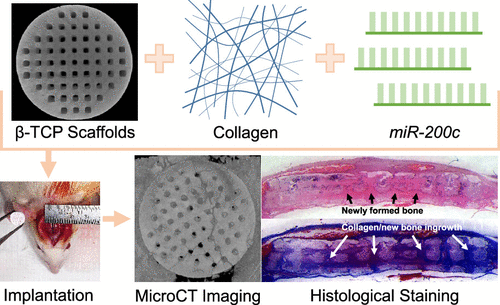当前位置:
X-MOL 学术
›
ACS Biomater. Sci. Eng.
›
论文详情
Our official English website, www.x-mol.net, welcomes your
feedback! (Note: you will need to create a separate account there.)
Rat Calvarial Bone Regeneration by 3D-Printed β-Tricalcium Phosphate Incorporating MicroRNA-200c
ACS Biomaterials Science & Engineering ( IF 5.4 ) Pub Date : 2021-08-26 , DOI: 10.1021/acsbiomaterials.0c01756 Matthew T Remy 1 , Adil Akkouch 1 , Li He 2 , Steven Eliason 3 , Mason E Sweat 2 , Tadkamol Krongbaramee 1 , Fan Fei 2 , Fang Qian 1 , Brad A Amendt 1, 3, 4 , Xuan Song 2 , Liu Hong 1, 4
ACS Biomaterials Science & Engineering ( IF 5.4 ) Pub Date : 2021-08-26 , DOI: 10.1021/acsbiomaterials.0c01756 Matthew T Remy 1 , Adil Akkouch 1 , Li He 2 , Steven Eliason 3 , Mason E Sweat 2 , Tadkamol Krongbaramee 1 , Fan Fei 2 , Fang Qian 1 , Brad A Amendt 1, 3, 4 , Xuan Song 2 , Liu Hong 1, 4
Affiliation

|
Advanced fabrication methods for bone grafts designed to match defect sites that combine biodegradable, osteoconductive materials with potent, osteoinductive biologics would significantly impact the clinical treatment of large bone defects. In this study, we engineered synthetic bone grafts using a hybrid approach that combined three-dimensional (3D-)printed biodegradable, osteoconductive β-tricalcium phosphate (β-TCP) with osteoinductive microRNA(miR)-200c. 3D-printed β-TCP scaffolds were fabricated utilizing a suspension-enclosing projection-stereolithography (SEPS) process to produce constructs with reproducible microarchitectures that enhanced the osteoconductive properties of β-TCP. Collagen coating on 3D-printed β-TCP scaffolds slowed the release of plasmid DNA encoding miR-200c compared to noncoated constructs. 3D-printed β-TCP scaffolds coated with miR-200c-incorporated collagen increased the transfection efficiency of miR-200c of both rat and human BMSCs and additionally increased osteogenic differentiation of hBMSCs in vitro. Furthermore, miR-200c-incorporated scaffolds significantly enhanced bone regeneration in critical-sized rat calvarial defects. These results strongly indicate that bone grafts combining SEPS 3D-printed osteoconductive biomaterial-based scaffolds with osteoinductive miR-200c can be used as superior bone substitutes for the clinical treatment of large bone defects.
中文翻译:

通过 3D 打印的含有 MicroRNA-200c 的 β-磷酸三钙进行大鼠颅骨再生
先进的骨移植制造方法旨在匹配将可生物降解的骨传导材料与有效的骨诱导生物制剂相结合的缺损部位,这将显着影响大骨缺损的临床治疗。在这项研究中,我们使用混合方法设计合成骨移植物,该方法将三维 (3D-) 打印的可生物降解、骨传导性 β-磷酸三钙 (β-TCP) 与骨诱导性 microRNA (miR)-200c 相结合。3D 打印的 β-TCP 支架是利用悬浮封闭投影立体光刻 (SEPS) 工艺制造的,以生产具有可重现微架构的结构,从而增强 β-TCP 的骨传导性能。3D 打印的 β-TCP 支架上的胶原蛋白涂层减缓了编码miR-200c的质粒 DNA 的释放与非涂层结构相比。涂有miR-200c胶原蛋白的3D 打印 β-TCP 支架提高了大鼠和人 BMSCs 的miR-200c的转染效率,并且还增加了体外 hBMSCs 的成骨分化。此外,掺入miR-200c的支架显着增强了临界大小的大鼠颅骨缺损中的骨再生。这些结果有力地表明,结合 SEPS 3D 打印的骨传导性生物材料支架与骨诱导性 miR-200c 的骨移植物可用作临床治疗大骨缺损的优质骨替代物。
更新日期:2021-09-13
中文翻译:

通过 3D 打印的含有 MicroRNA-200c 的 β-磷酸三钙进行大鼠颅骨再生
先进的骨移植制造方法旨在匹配将可生物降解的骨传导材料与有效的骨诱导生物制剂相结合的缺损部位,这将显着影响大骨缺损的临床治疗。在这项研究中,我们使用混合方法设计合成骨移植物,该方法将三维 (3D-) 打印的可生物降解、骨传导性 β-磷酸三钙 (β-TCP) 与骨诱导性 microRNA (miR)-200c 相结合。3D 打印的 β-TCP 支架是利用悬浮封闭投影立体光刻 (SEPS) 工艺制造的,以生产具有可重现微架构的结构,从而增强 β-TCP 的骨传导性能。3D 打印的 β-TCP 支架上的胶原蛋白涂层减缓了编码miR-200c的质粒 DNA 的释放与非涂层结构相比。涂有miR-200c胶原蛋白的3D 打印 β-TCP 支架提高了大鼠和人 BMSCs 的miR-200c的转染效率,并且还增加了体外 hBMSCs 的成骨分化。此外,掺入miR-200c的支架显着增强了临界大小的大鼠颅骨缺损中的骨再生。这些结果有力地表明,结合 SEPS 3D 打印的骨传导性生物材料支架与骨诱导性 miR-200c 的骨移植物可用作临床治疗大骨缺损的优质骨替代物。











































 京公网安备 11010802027423号
京公网安备 11010802027423号